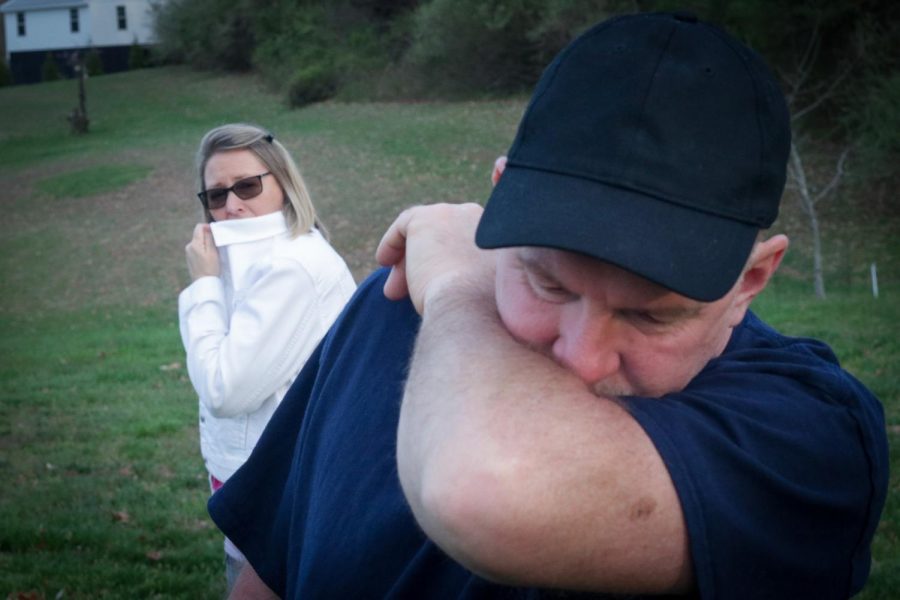The Coronavirus Versus The Flu
Someone coughing into their arm, with someone looking at them scared. In the current world we live in, if you cough, you are probably going to be suspected of this coronavirus, and people are going to look at you scared.
April 8, 2020
Don’t cough, sneeze, or show any symptoms of the coronavirus, or you’re going to be suspected of this virus.
In this world that everyone currently lives in, if someone coughs, or sneezes, or has any symptoms of the coronavirus, most people instantly suspect that they have the coronavirus.
There are many differences between the coronavirus and the flu. Now, although there are a lot of differences, there are some similarities between the coronavirus and the flu. If somebody coughs, you might want to take precautions, but you shouldn’t instantly suspect that they have the coronavirus.
One of the biggest differences that people are pointing out is the fact that the flu does have a vaccine, while the coronavirus does not. Therefore, the only way for the coronavirus to get out of you, is for it to die inside you.
How long it will take for the coronavirus to get a vaccination, the world does not know, but people have had educated assumptions. “For a new coronavirus vaccine to be available for large populations, I would say it’s a matter of two years minimum,” professor of the University of Pennsylvania, Dr. Stanley Plotkin, professor emeritus at the University of Pennsylvania, previously told Business Insider’s Andrew Dunn. Now, according to Business Insider, Plotkin has worked in vaccine development since the 50s. In fact, U.S. National Institutes of Health officials have actually launched a phase that is one clinical trial, and it could perhaps be a potential vaccine for the coronavirus.
If you have the Flu, and you’re around a group of people, your Flu will, on average, spread to 1.3 people. Now, if you have the Coronavirus, and you’re around a group of people, your Coronavirus will, on average, spread to 3 people. So, on average, if this happened 10 times, for the Flu, you would have been the cause for infecting 13 people, and those 13 people will also be infecting the average of 1.3 people as well. Now, on average, if this happened ten times, for the Coronavirus, you would have been the cause for infecting 30 people, and those 30 people will also be infecting the average of 3 people as well.
According to the Centers for Disease Control and Prevention, from Oct. 1, 2019 to March 28, 2020, there have been around 39 million to 55 million flu illnesses, around 18 million to 26 million flu medical visits, around 400,000 to 730,000 flu hospitalizations, and around 24,000 to 63,000 flu deaths. That is close to six months, in time.
Now, in the past four months, (since Dec. 31, which was the day that the government in Wuhan, China, confirmed that their health authorities had been treating dozens of cases in Wuhan), there have been, according to John Hopkins University, 378,289 coronavirus cases, 20,003 coronavirus cases recovered, and 11,830 deaths.
So, in that last aspect mentioned, the flu is hurting more than the coronavirus, but there are many more differences that was not mentioned.
We’ll start off with the most obvious similarity of them all: they’re both contagious diseases that are making people extremely sick, sometimes to the point of it being fatal.
Now, the way to lower your risk of the coronavirus, is by washing your hands, avoiding the public as much as possible, social distancing, etc., and if you’re wanting to be sure about you not getting the flu, those are some ways to prevent the flu as well.
The symptoms of the coronavirus and the flu are actually pretty similar as well. According to Centers for Disease Control and Prevention, the symptoms of the coronavirus that you could experience are a cough, a fever, the feeling of being tired (fatigue), and some difficulty breathing (sometimes severe).
Now, according to Centers for Disease Control and Prevention, the symptoms of the flu that you could experience are the fever, a feeling of the fever, a cough, a sore throat, a runny/stuffy nose, muscle/body aches, headaches, the feeling of fatigue (tiredness), and some people may have vomiting.
Now, you can just instantly see the similarities between those two virus’ symptoms. So, if you’re in public, and see someone coughing, sneezing, looking tired, or overall, looking sick, that doesn’t instantly mean that they have the coronavirus. They could just have the flu, or something like that.
So, next time someone’s out in public, (which should be rarely), and you see someone experiencing the symptoms of the coronavirus, truly do be careful around them, but don’t freak out, and instantly suspect that they have the coronavirus.















